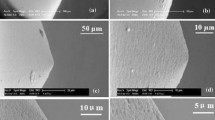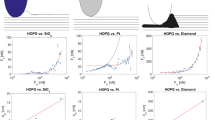Abstract
A diamond indentor is attached to the periphery of an aluminium wheel and slid against ferrite and sapphire surfaces at high speed. A high-frequency response infrared sensor is used to measure the average diamond tip temperature and a piezoelectric dynamometer is used to measure the normal and tangential forces acting on the indentor. The analytical procedure estimates the heat flux at the contact as the product of the shear traction and the tangential velocity. The heat flux is used in conjunction with a Green's function to calculate the interface temperature and the tangential surface stress. The calculated and measured grain tip temperatures are compared and the relative magnitudes of the mechanical and thermal surface stresses are calculated. Finally, the importance of thermal effects on the wear and surface finishing of ceramics is discussed.
Similar content being viewed by others
References
R. J. Stokes, in “The Science of Ceramic Machining and Surface Finishing”, Vol. I, edited by B. J. Hockey and S. J. Schneider (National Bureau of Standards, Washington, 1972) p. 343.
D. Johnson-Walls, A. G. Evans, D. B. Marshall andM. R. James,J. Amer. Ceram. Soc. 69 (1986) 44.
E. Klockholm andJ. Wolfe, “Dead Layers in Mn-Zn and Ni-Zn Ferrites”, Research Report (IBM T. J. Watson Research Center, New York, 1983).
S. Chandrasekar, M. C. Shaw andB. Bhushan, in “Tribology and Mechanics of Magnetic Storage Systems”, Vol. III, ASLE Special Publication 21, edited by B. Bhushan, D. Bogy and N. Eiss (American Society for Lubrication Engineering, Chicago 1986) p. 41.
B. Lawn andT. R. Wilshaw, “Fracture of Brittle Solids” (Cambridge University Press, 1976).
B. Lawn andT. R. Wilshaw,J. Mater. Sci. 10 (1975) 1049.
D. Rigney, (ed.) “Fundamentals of Friction and Wear of Materials”, ASM Materials Science Seminar, October 1980 (American Society for Metals, Metals Park, Ohio, 1981).
H. Blok,Proc. Inst. Mech. Eng. 2 (1937) 222.
J. C. Jaeger,Proc. Royal Soc. New South Wales 56 (1942) 203.
J. F. Archard,Wear 2 (1958) 438.
B. Bhushan andN. H. Cook,J. Lub. Tech. 95 (1973) 535.
J. E. Mayer andM. C. Shaw,ASLE J. 13 (1956) 21.
R. Gulino, S. Bair, W. O. Winer andB. Bhushan,J. Tribol. 108 (1986) 29.
S. Chandrasekar, T. N. Farris andB. Bhushan,ibid. (1990) in press.
T. Ueda, A. Hosokawa andA. Yamamoto,J. Engng Ind. 107 (1985) 127.
“Optical Properties and Applications of Linde-Cz Sapphire”, Union Carbide, Technical Bulletin F-CPD 72950 (1972).
“Engineering Properties of Ceramics”, Battelle Memorial Institute, Technical Report AFML-DR 66-52, June 1966.
S. Chandrasekar andT. N. Farris, “Infrared Grinding Temperatures”, Technical Report, Schools of Industrial Engineering and Aeronautics and Astronautics, Purdue University, March 1989.
R. M. Chrenko andH. M. Strong, “Physical Properties of Diamond”, Technical Report No. 75CRD089, General Electric Company, October 1975.
J. R. Barber,J. Appl. Mech. 51 (1984) 636.
M. D. Bryant,ibid. 55 (1988) 87.
M. Abramowitz andI. A. Stegun, “Handbook of Mathematical Functions”, 9th Edn (Dover, 1972) Ch. 9.
H. S. Carslaw andJ. C. Jaeger, “Conduction of Heat in Solids”, 2nd Edn (Oxford University Press, 1959).
S. Ramanath andM. C. Shaw,J. Engng Ind. 110 (1988) 15.
K. L. Johnson, “Contact Mechanics” (Cambridge University Press, 1985) Ch. 2, 7.
R. Samuel, S. Chandrasekar, T. N. Farris andR. H. Licht,J. Amer. Ceram. Soc. 72 (1989) 1960.
Author information
Authors and Affiliations
Rights and permissions
About this article
Cite this article
Farris, T.N., Chandrasekar, S. High-speed sliding indentation of ceramics: thermal effects. J Mater Sci 25, 4047–4053 (1990). https://doi.org/10.1007/BF00582480
Received:
Accepted:
Issue Date:
DOI: https://doi.org/10.1007/BF00582480




